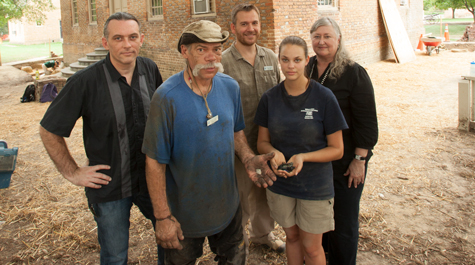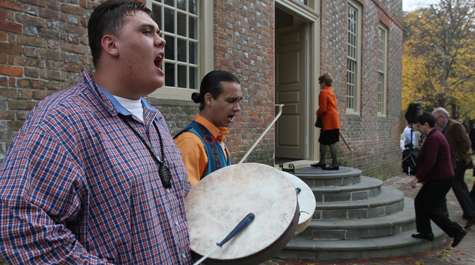President signs legislation granting federal recognition to six Virginia tribes
UPDATE: U.S. Rep. Rob Wittman (VA-01) announced on Jan. 29 that President Donald Trump has signed into law H.R. 984, the Thomasina E. Jordan Indian Tribes of Virginia Federal Recognition Act of 2017.
This legislation grants federal recognition to six Virginia Indian tribes. Rep. Wittman introduced the bill on Feb. 7, 2017. The bill passed the House by voice vote on May 17, 2017 and the Senate by unanimous consent on January 11, 2018.
“Today we celebrate a decade of hard work. Our ‘first contact' tribes of the Commonwealth of Virginia will finally receive the recognition they deserve,” Wittman said in a release. “This is an issue of respect; federal recognition acknowledges and protects the historical and cultural identities of these tribes. Not only will it affirm the government-to-government relationship between the United States and the Virginia tribes, but it will create opportunities to enhance and protect the well-being of tribal members.”
This law grants federal recognition to the Chickahominy, the Eastern Chickahominy, the Upper Mattaponi, the Rappahannock, the Monacan and the Nansemond tribes. Federal recognition grants Virginia’s tribes legal standing and status in relationships with the U.S. government. This status enables the tribes to pursue repatriation of historical and cultural artifacts, comment on federal agency actions that could affect their future, and gain access to a number of federal programs.
********
Six Indian tribes of eastern Virginia are one signature away from full federal recognition, after the U.S. Senate approved H.R. 984.
The bipartisan legislation would extend federal recognition to the Chickahominy, the Eastern Chickahominy, the Upper Mattaponi, the Rappahannock, the Monacan, and the Nansemond tribes. The tribes have previously received recognition from the Commonwealth of Virginia, but gaps in historical record hindered their federal recognition. A seventh tribe, the Pamunkey, received federal recognition in 2016.
The bill, which was introduced by Virginia Congressman Rob Wittman last February, passed the House by voice vote in May. It passed the Senate without amendment on Thursday and now heads to President Donald Trump’s desk for signing into law.
“William & Mary’s 325-year story is interwoven with the history of Native Americans, in particular the story of the young boys who attended our Indian School and the families they left behind to do so,” said President Taylor Reveley. “It is good to see the six tribes well on their way to joining the Pamunkey in federal recognition. We congratulate them.”
As part of the historical narrative supporting federal tribal recognition, H.R. 984 cites the establishment of Brafferton College, a grammar school for Native Americans, at William & Mary in 1711. It notes that Chickahominy and Nansemond children were some of the first Indians to attend Brafferton College.
“Decades in the making, federal recognition will acknowledge and protect historical and cultural identities of these tribes for the benefit of all Americans,” Wittman said in a statement. “It will also affirm the government-to-government relationship between the United States and the Virginia tribes, and help create opportunities to enhance and protect the well-being of tribal members.”
Federally-recognized status would enable the tribes to pursue repatriation of historical and cultural artifacts, comment on federal agency actions and gain access to a number of programs that serve the country’s more than 560 federally recognized tribes, Wittman said.
Opponents of the bill expressed concern that federal recognition would pave the way for casinos, despite language in the bill that prohibits gaming activities of any kind. The bill also maintains existing tribal hunting, fishing, trapping, gathering and water rights and will not “expand, reduce, or affect” the current policy.
Many members of the William & Mary community expressed surprise and delight at the passage of H.R. 984. The feeling was strongest among those who have had direct involvement with the groups.
“A number of us at William & Mary have worked closely with these groups,” said archaeologist Martin Gallivan. “But the Chickahominy, Monacan, Rappahannock, Nansemond, Eastern Chickahominy and Upper Mattaponi deserve all the credit for persevering with recognition, long past the point when others would probably have given up.”
William & Mary’s connection to the Native peoples of the region that they called Tsenacommacah goes back to the time of the institution’s 1693 charter and the interest of scholars and scientists goes back even further, of course.
Reminders of William & Mary’s connection with the original inhabitants of the region dot today’s campus. Lake Matoaka bears the given name of Pocahontas, daughter of Chief Powhatan. The Brafferton, prime real estate on the Historic Campus and the location of the offices of the university’s provost and president, originally housed William & Mary’s Indian School. The building is, of course, the very Brafferton College mentioned in Wittman’s bill.
Pre-renovation archaeology at the Brafferton involved two members of the Pamunkey tribe. Jeff Brown, now deceased, was also involved in many other excavations, as was Ashley Atkins Spivey, who received her Ph.D. from the William & Mary Department of Anthropology in 2017 and now serves as tribal liaison for the department's native studies minor and the American Indian Resource Center at William & Mary. The excavations uncovered artifacts connected with students at the Indian school.
A 2016 exhibition at William & Mary’s Muscarelle Museum of Art, “Building the Brafferton: The Founding, Funding and Legacy of America’s Indian School,” brought together documents, historical paintings, engravings and other artifacts including personal items related to students of the school, including Thomas Step of the Nottoway tribe and Henry Bawbee of the Wyandot tribe at Fort Pitt.
The “Building the Brafferton” exhibit was curated by Buck Woodard Ph.D. ’13 and Danielle Moretti-Langholtz, research assistant professor in the Department of Anthropology. Moretti-Langholtz also serves as director of the American Indian Resource Center.
Founded in 1998, the American Indian Resource Center works to foster communication and collaboration among scholars and members of the Native communities. A major function of the center has been to facilitate involvement of members of descendant communities in decisions that concern archaeological examinations connected with their ancestors.
“It was a place to support faculty, tribal outreach, civic engagement. But I found that I was getting calls from Indian communities who remembered that they had a history with William & Mary,” Moretti-Langholtz said. “They would call to ask about the Brafferton: Did Indians still come back to the school?”
Interactions through the American Indian Resource Center led Moretti-Langholtz and Kathleen Bragdon, professor of anthropology, to start planning a minor program devoted to the studies of indigenous peoples. The native studies minor began enrolling students last year and organizers of the program believe it will be yet another way to strengthen the university’s connections with native peoples.
In addition to institutional involvement, the ancestors of the seven tribes have been the focus of a large amount of study by William & Mary researchers.
Gallivan’s 2016 book The Powhatan Landscape: An Archaeological History of the Algonquian Chesapeake outlines insight from historical and archaeological records on the region controlled by paramount chief Powhatan from his capital city of Werowocomoco on the north side of the York River. Gallivan led the archaeological investigation of Werowocomoco after its rediscovery in 2002.
Werowocomoco and its inhabitants figure prominently in the history and mythology of early America. Jamestown colonist John Smith was taken to Werowocomoco after being captured by Powhatan’s brother Opchanacanough. It’s the location of the events related in the well-known legend of how Pocahontas intervened in the execution of Smith, saving his life.
Gallivan deals with the Pocahontas-Smith story in The Powhatan Landscape. His hypothesis is that something happened, but that it’s likely that Smith misinterpreted a Powhatan “conjuration ceremony,” aimed at determining the intentions of the new English colonists.
“I don’t know of any other examples in the Algonquin world of something like the Pocahontas-John Smith story,” Gallivan said. “So it’s difficult to place this event in a cultural or historical context.
Werowocomoco, lost for centuries, has received an increasing amount of attention — and protection — over the past decade. The high point was a ceremonial signing of a conservation easement in 2013 on the site. Representatives of all seven tribes were on hand as was Wittman and then-Governor Bob McDonnell. The tribal representatives stressed the point that American history did not begin with the Jamestown colony, many of them speaking along the lines of Chickahominy Chief Stephen R. Adkins.
“The archaeological discoveries and attendant interpretation of the Werowocomoco Research Group, led by Dr. Martin Gallivan, ripped to shreds the Anglo-centric term ‘pre-history’ as it relates to the history of this land and its indigenous people prior to the arrival of the invaders in 1607,” Adkins told a crowd of several hundred. “Today we honor the polity, social order, economic enterprise, religious customs, agricultural prowess, engineering feats and craftsmanship of our ancestors.”
The Werowocomoco site holds the potential for a great deal more archaeology and the conservation easement protects the site from development. The protection was extended further in 2016, when the U.S. National Park Service brought the site under its umbrella for development as part of the John Smith Water Trail.
Archaeology can help to form understanding of the people who lived in places with thin records in written history, particularly pre-contact cities such as Werowocomoco and Kiskiack, another Powhatan town across the York River. Additionally, archaeology can help to confirm or to challenge received history and cultural narratives.
Audrey Horning ’89 is Arts and Sciences Distinguished Professor of Anthropology at William & Mary. Her book Ireland in the Virginian Sea: Colonialism in the British Atlantic, published by the Omohundro Institute, is a comparison of the Jamestown colonial experience with that of the Ulster Plantation.
Horning has said that she believes that the most important revelation to come out of the Jamestown Rediscovery excavations is “the imprint of Native Virginia.” She points that most of the ceramics recovered from the early James Fort period were native-made.
“Eighty percent — that’s a lot,” she said. “That’s not the occasional pot coming in. That’s evidence of daily contact, and it shows a certain willingness on the part of the English to engage in ways that history hasn’t always allowed for.”

















